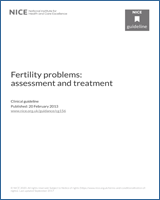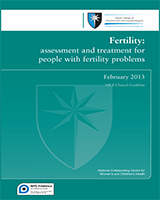Excerpt
This guideline offers best practice advice on assisting people of reproductive age who have problems conceiving.
It is estimated that infertility affects about one in seven heterosexual couples in the UK. Since the original NICE guideline on fertility was published in 2004 there has been a small increase in the prevalence of fertility problems and a greater proportion of people now seeking help for such problems.
The main causes of infertility in the UK are (percentage figures indicate approximate prevalence): ovulatory disorders (25%); tubal damage (20%); factors in the male causing infertility (30%); uterine or peritoneal disorders (10%).
In about 25% of cases infertility is unexplained, with no identified male or female cause.
In about 40% of cases disorders are found in both the man and the woman. Uterine or endometrial factors, gamete or embryo defects, and pelvic conditions such as endometriosis may also play a role.
Given the range of causes of fertility problems, the provision of appropriate investigations is critical. These investigations include semen analysis; assessment of ovulation, tubal damage and uterine abnormalities; and screening for infections such as Chlamydia trachomatis and susceptibility to rubella.
Once a diagnosis has been established, treatment falls into three main types: medical treatment to restore fertility (for example the use of drugs for ovulation induction); surgical treatment to restore fertility (for example laparoscopy for ablation of endometriosis); assisted reproduction technology (ART) – any treatment that deals with means of conception other than vaginal coitus; frequently involving the handling of gametes or embryos.
While every effort has been made to ensure the accuracy of the information contained within this publication, the publisher can give no guarantee for information about drug dosage and application thereof contained in this book. In every individual case the respective user must check current indications and accuracy by consulting other pharmaceutical literature and following the guidelines laid down by the manufacturers of specific products and the relevant authorities in the country in which they are practising.
This guideline has been fully funded by NICE. Healthcare professionals are expected to take it fully into account when exercising their clinical judgement. However, the guidance does not override the individual responsibility of healthcare professionals to make decisions appropriate to the circumstances of the individual patient.
Implementation of this guidance is the responsibility of local commissioners and/or providers


